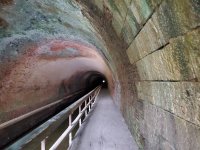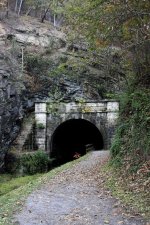And there's another nice reason to visit Paw Paw....
Today the Paw Paw Tunnel can be easily explored with a flashlight, as the towpath is still intact. Trekkers can return via the tunnel, or hike back over the two-mile-long (3.2 km) Tunnel Hill Trail. This passes interpretive markers about the German and Irish workers who lived along the path during the tunnel's construction.
The Paw Paw Tunnel is a 3,118-foot-long (950 m) canal tunnel on the Chesapeake and Ohio Canal (C&O) in Allegany County, Maryland.[1] Located near Paw Paw, West Virginia, it was built to bypass the Paw Paw Bends, a six-mile (9.7 km) stretch of the Potomac River containing five horseshoe-shaped bends. The town, the bends, and the tunnel take their name from the pawpaw trees that grow prolifically along nearby ridges.
Built using more than six million bricks, the tunnel has been described as "the greatest engineering marvel along the Chesapeake & Ohio Canal National Historical Park." Located at milepost 155.2, the tunnel served to eliminate six miles of canal and is credited with contributing to the economic success of nearby Cumberland, Maryland. [2]
Construction on the tunnel began in 1836 and was expected to be completed within two years at a total cost of $33,500. But the project proved far more complicated and costly than expected, and the tunnel would not open until 1850, more than a decade behind schedule.
The project was delayed for many reasons. Not only did the construction company underestimate the difficulty of the work, violence frequently broke out among immigrant laborers of different ethnicities, and wages often went unpaid due to the company's financial problems.[3] By the time the tunnel was finally completed at a price of $600,000, it had nearly bankrupted the Chesapeake and Ohio Canal Company. Due to the high cost and long delay in completing the tunnel, the construction would end at Cumberland, Maryland falling short of the original plan to take it all the way to Pittsburgh.
The tunnel was used by canal boats until the C&O closed in 1924. The tunnel and towpath are now maintained for public use as part of the Chesapeake and Ohio Canal National Historical Park. Though never one of the longest tunnels in the world, Paw Paw Tunnel remains one of the greatest engineering feats of its day.[4]




